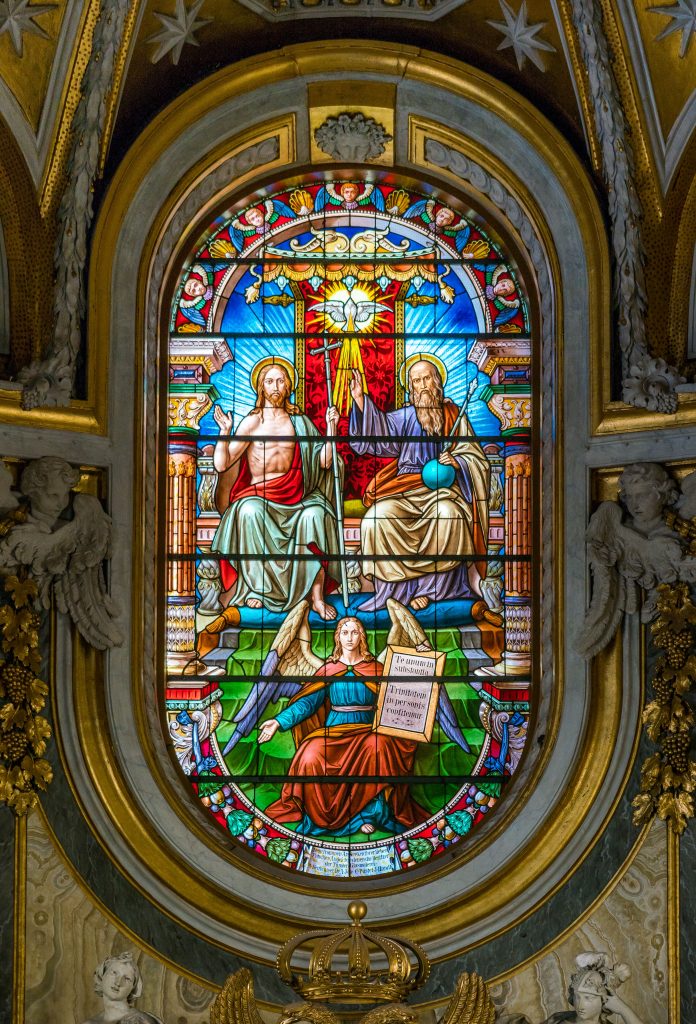Werncelebrate the Solemnity of the Most Holy Trinity each year on the Sunday afterrnPentecost.
ThernTrinity is a religious symbol that enables us to become more fully engaged inrnrelationship with our God who is “utterly transcendent, but also enfleshed historicallyrnin Jesus Christ, while also continually present through the Spirit” (ElizabethrnJohnson and Julia H. Brumbaugh, Scripture from Scratch).
Thesernimages of Father, Son and Spirit offer us a way of entering into relationshiprnwith the immanent presence of God, both personally and communally. It is important,rnthough, to always remember that the presence of God cannot be fully explainedrnin such a literal manner.
“Onernof the challenges of theology is the inadequacy of human language in broachingrnthe mystery of God. At the same time, the task of the theologian is to attemptrnto craft language that is more and more effective for inviting people into thernmystery in each context and in every age” (Fr. Ed Foley, Encountering thernMystery).
Thernchurch, over the centuries, has imagined and gathered together words and ideasrnto help explain God, but no combination of these can fully explain the mystery.
Therndoctrine of the Trinity helps us speak of the vastness of God, but it is notrnintended to be a literal explanation. It is a way of participating inrnrelationship with God, a way of living in the divine communion to which we are allrncalled.
“ThernTrinity is a religious doctrine that reveals its truth only according to thernpower of the symbol, that is, by way of metaphor or analogy. All religiousrnspeech is like this, like a finger pointing to the moon” (Elizabeth Johnson andrnJulia H. Brumbaugh, Scripture from Scratch). “Tornequate the finger with the moon, or to acknowledge the finger and not perceivernthe moon, is to miss the point” (Phyllis Trible, Scripture from Scratch).
Ourrnliturgy, too, can be understood as “a finger pointing to the moon.” As we havernmentioned previously in these articles, this idea is akin to what the Catechismrnof the Catholic Church refers to as moving from “the visible to the invisible.”
Inrncelebrating the Mass, we use various forms of human expression to respond tornGod’s call to share in communion with the divine mystery. All of those forms ofrnexpression are fingers pointing to the moon.
Theyrnare symbols, and symbol is the language we have to celebrate these mysteriesrnfor which there is no literal or completely cognitive understanding orrnlanguage. The liturgy is our framework for responding to God as community.
Justrnas the Trinity is an invitation into relationship with God, so, too, thernliturgy is an invitation into that relationship as a community. It is not sornmuch about our individual piety as it is about our lives as the body of Christ,rncommunity in Christ.
So, what can a parish liturgy committee do to prepare forrnTrinity Sunday? This would be the day to prepare all of our symbol languagesrnwith great care and love. Discuss the symbols of movement, song, silence, storyrnand word. Rehearse them. Open them up. Make them big. Let them speak so loudlyrnthat the space and the people in it reverberate with God’s energy and presence.
The liturgy is where the body of Christ is home together.rnThis is the day to do everything possible to create a hospitable environmentrnfor all who come to participate. Welcome them home!
Choose an opening song that is so familiar to the assemblyrnas to call forth a full and conscious response. Sing all the verses. Let thernprocession be slow, deliberate, integrated with the rhythm of the song. Takernyour time. Give everyone the opportunity to become immersed in the moment, tornbe brought together and connected as one body in Christ.
Be sure the Word is reflected upon, rehearsed, prepared andrnproclaimed with strength and power. Choose songs throughout the liturgy that unite the assembly asrnone voice. Letrnthe procession and the sharing in communion reflect a graciousness and beautyrnthat is strong enough to carry the weight of the mystery in which wernparticipate.
Thernway we do liturgy emanates the desires of our hearts. On this day, and everyrnSunday, let that desire for communion with God and with all humanity be seenrnand felt by all who participate. If that union in God’s love, through Christ,rnin the power of the Holy Spirit reverberates strongly among us, it will go outrninto the world and find a home there, too, “like a finger pointing to thernmoon.”

